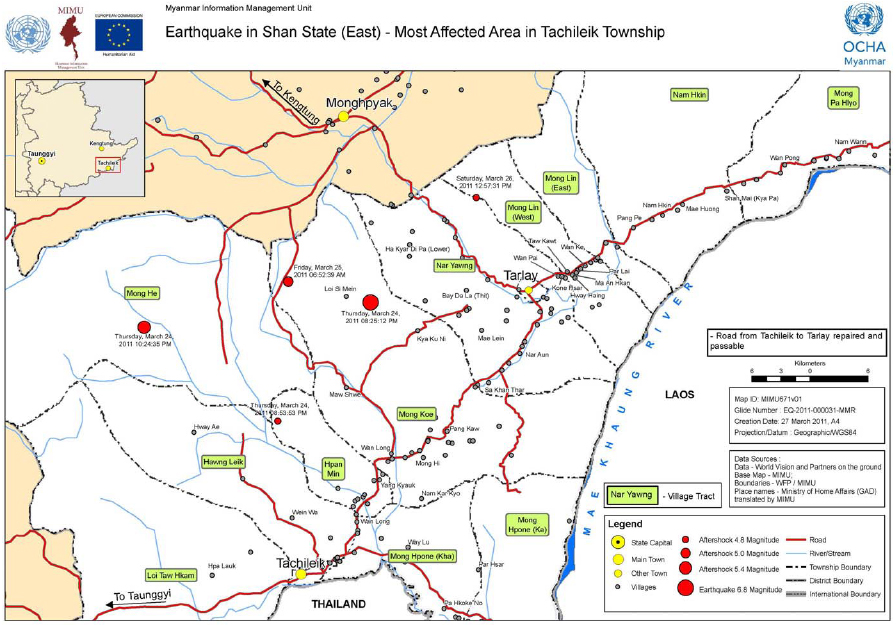Hundred
s of victims affected by Thursday’s ( 24 March) earthquake of magnitude-6.8 in Talerh (Talay) and Mong Lane (Monglin) village tracts of Shan State East’s Talerh sub-township, Tachilek district, are still reportedly lacking access to food ...
Hundreds of victims affected by Thursday’s ( 24 March) earthquake of magnitude-6.8 in Talerh (Talay) and Mong Lane (Monglin) village tracts of Shan State East’s Talerh sub-township, Tachilek district, are still reportedly lacking access to food and aid even though relief supplies are being distributed from local and international communities everyday, according to local sources.

Everyone is told to line up in queue to wait for food and medicine from the local authorities as supplies were controlled by the local authorities and were only given at the junta run relief center. Nevertheless, supplies are only being distributed in very small amounts although lots of support was pouring from several places and neighborhood, said a 65-year old elderly person from Talerh who went to ask for food on 26 March at the relief shelter.
“They [military junta] told us to go and sit in a line. Then they took our photos. Afterwards, we had to be in line at the relief center everyday from 8AM to 3 PM. But it was just a waste of time because we just received only one bag of instant noodles and a bottle of water each. No more than those,” he said.
Food and supplies like blankets, mats and tarpaulins for impacted villagers mainly come from people in Tachilek and Mae Sai, and some from Keng Tung. In addition, those impacted villagers are still living in tents in front of their damaged and collapsed houses.
Nang Lao from the same village also shared her experience that she had to wait for almost a day to receive the food until the ‘Phu Yai (superiors)’ came to give permission. “We had to wait for a long time for nothing, while worrying about more damage after the aftershocks.”
An aid worker from an NGO also told SHAN that they were not allowed to hand relief supplies directly to the villagers. They were only asked to drop their things at the junta’s relief shelters.
“We have to pile up all our supplies and donations at the aid centers and have to wait for ‘permission’ before delivering them to the villagers,” she said.
“Villagers are suffering as they do not have enough to eat or drink. Some family received only 2 bags of instant noodles. We know that it was not enough for them. But we could do nothing except tell them to share with each other,” she added.
There were only three relief centers being set up in the area: one in Mong Lane and two in Talerh, where hundreds of people are expected to have lost their lives under their collapsed buildings.
“One of the aid centers in Talerh is located at the head of the bridge (before crossing to Ta Lerh), opposite an army camp. There are a lot of security armed guards at the bridge, who have been temporarily repairing the damaged road, but causing traffic hold-ups for people bringing donations from Tachilek. Thus everyone has to leave their donations at the aid center before the bridge,” said the aid worker.
Apart from the local communities, even UN and NGO aid must be piled at the aid center even though they got permission from high level authorities. UNICEF and Myanmar Red Cross have provided support both in Mong Lane and Ta Lerh.
However, up to date, an accurate data of the deaths have yet been known as equipment to search for the dead bodies are insufficient. Currently, the death toll from the areas could rise to hundreds, approximately at least about 200, according to local relief workers who are currently still in the area.
But the official announcement from MRTV4, the junta-run television station only said that only 74 died and 125 injured.
The latest report from Office for the Coordination of Humanitarian Affairs (OCHA) which is in collaboration with humanitarian groups said that since the earthquake struck and as of 27 March evening, a total of eight aftershocks have been reported and the affected areas remain in the risk of landslides. And the number of damaged houses has increased from 224 to 305 including a number of government buildings.
The Talerh based Relief and Resettlement Department has estimated the damage of the earthquake approximately at Kyat 3 billion (US$ 3.6 million), the report said.



